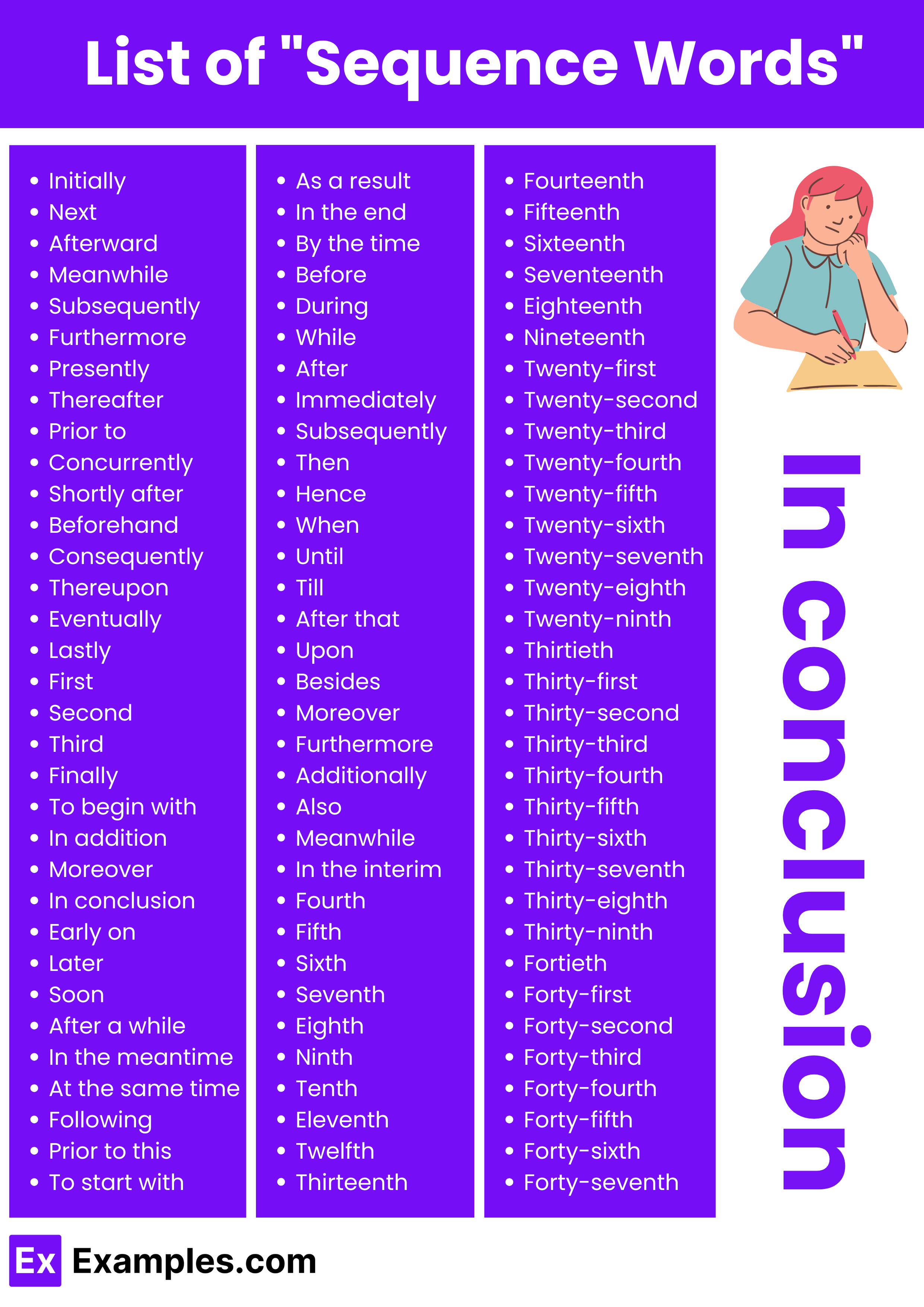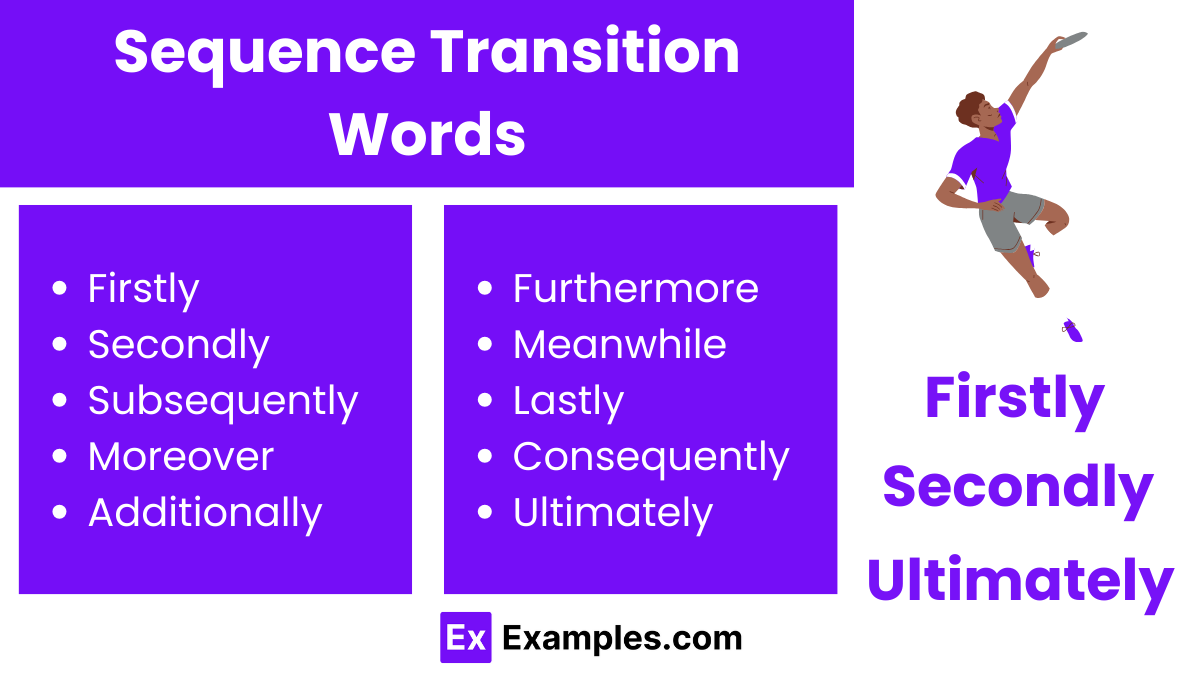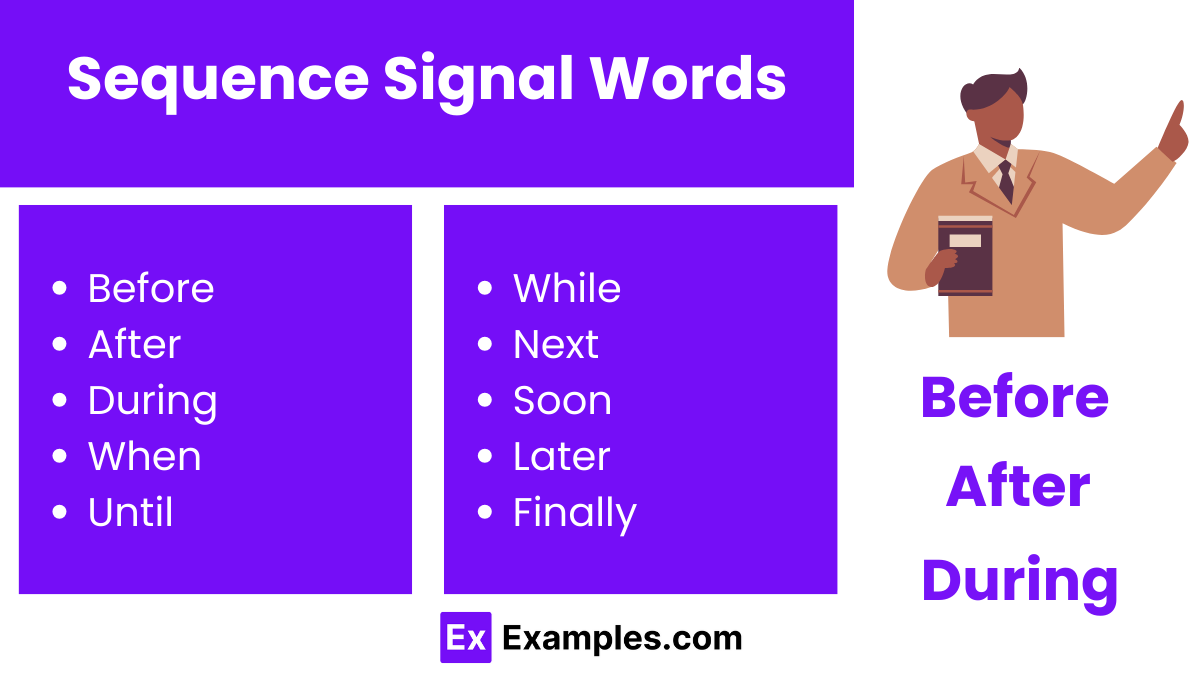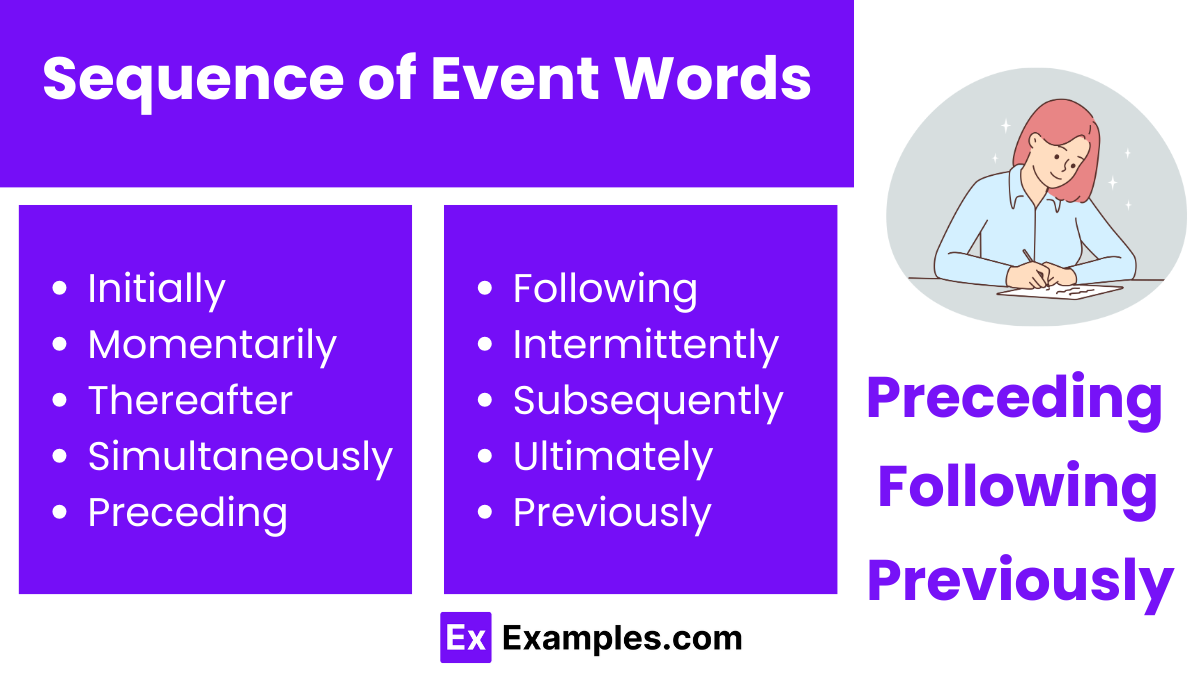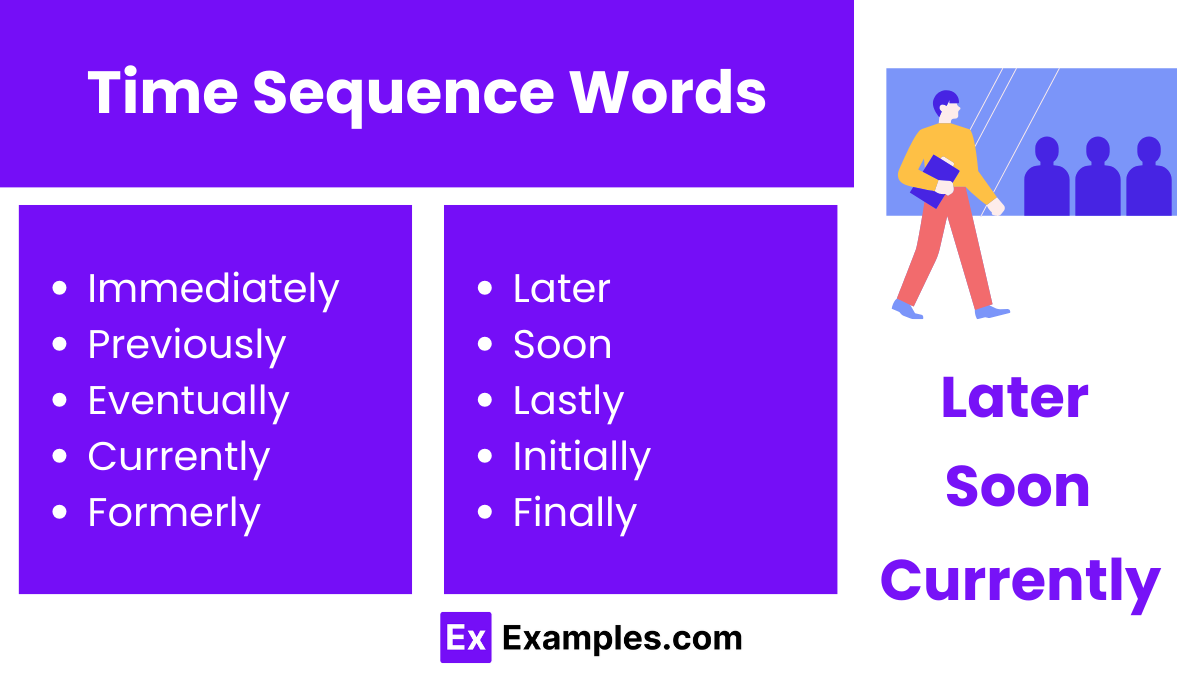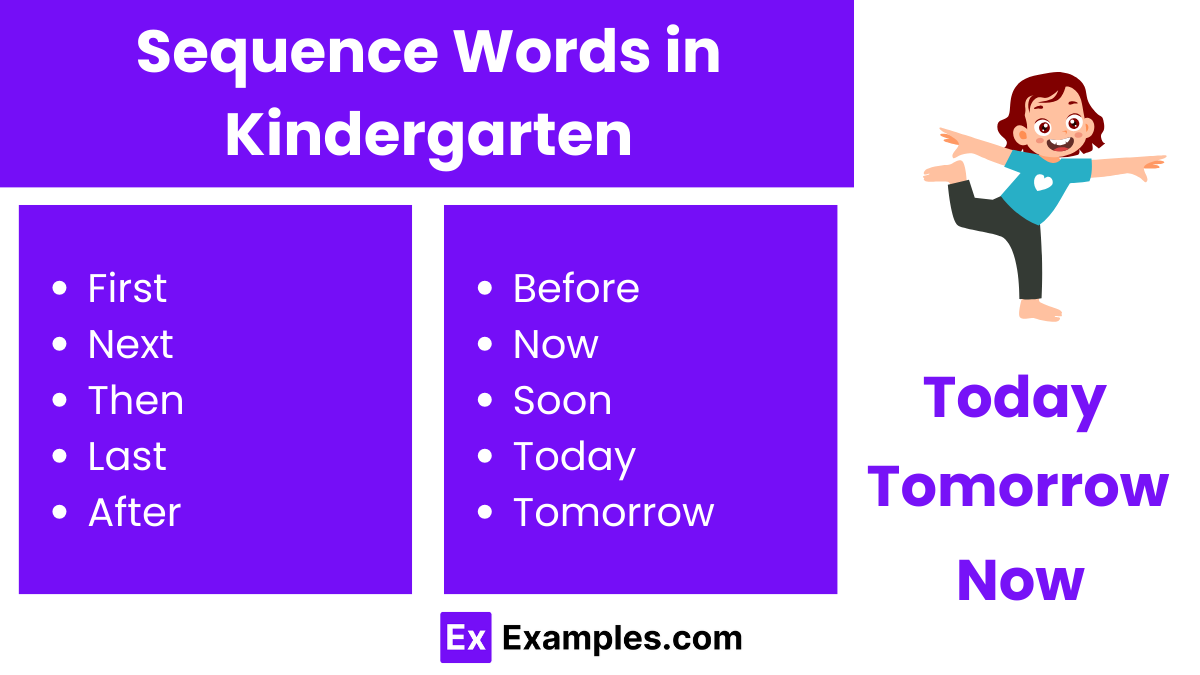450+ Sequence Words List, Meaning, PDF
Embarking on the exploration of “Sequence Words” unveils the secret to crafting stories and arguments with clarity and impact. These linguistic signposts guide readers through the twists and turns of your thoughts, ensuring a smooth journey from start to finish. Ideal for writers, educators, and students alike, understanding sequence words is crucial for structuring narratives, essays, and even daily conversations. This introduction serves as your gateway to mastering the art of effective communication, by illuminating the path from one idea to the next, making complex information digestible and engaging. Discover the power of sequence words and transform your ability to communicate ideas with precision and ease.
Download List of Sequence Words - PDF
100+ List of Sequence Words
Sequence words play an invaluable role in enriching communication, enabling speakers and writers to articulate the order of events, logical progressions, and procedural steps with clarity and precision. These words serve as signposts, guiding the audience through narratives, explanations, and arguments, ensuring a seamless flow of information. They are fundamental in teaching and learning, aiding students in structuring their thoughts and writings in a coherent manner. By mastering sequence words, learners can significantly improve their storytelling, descriptive writing, and the ability to present arguments or instructions. This curated list of sequence words, though not exhaustive, provides a glimpse into the vast array of options available for enhancing linguistic expression and comprehension.
| Initially | Next | Afterward | Meanwhile |
| Subsequently | Furthermore | Presently | Thereafter |
| Prior to | Concurrently | Shortly after | Beforehand |
| Consequently | Thereupon | Eventually | Lastly |
| First | Second | Third | Finally |
| To begin with | In addition | Moreover | In conclusion |
| Early on | Later | Soon | After a while |
| In the meantime | At the same time | Following | Prior to this |
| To start with | As a result | In the end | By the time |
| Before | During | While | After |
| Immediately | Subsequently | Then | Hence |
| When | Until | Till | After that |
| Upon | Besides | Moreover | Furthermore |
| Additionally | Also | Meanwhile | In the interim |
| Fourth | Fifth | Sixth | Seventh |
| Eighth | Ninth | Tenth | Eleventh |
| Twelfth | Thirteenth | Fourteenth | Fifteenth |
| Sixteenth | Seventeenth | Eighteenth | Nineteenth |
| Twenty-first | Twenty-second | Twenty-third | Twenty-fourth |
| Twenty-fifth | Twenty-sixth | Twenty-seventh | Twenty-eighth |
| Twenty-ninth | Thirtieth | Thirty-first | Thirty-second |
| Thirty-third | Thirty-fourth | Thirty-fifth | Thirty-sixth |
| Thirty-seventh | Thirty-eighth | Thirty-ninth | Fortieth |
| Forty-first | Forty-second | Forty-third | Forty-fourth |
| Forty-fifth | Forty-sixth | Forty-seventh | Forty-eighth |
| Forty-ninth | Fiftieth | Fifty-first | Fifty-second |
| Sequentially | Simultaneously | Preceding | Following |
| Ultimately | Temporarily | Permanently | Intermediately |
| Historically | Subsequently | Antecedently | Consequently |
| Commencing | Continuing | Ceasing | Resuming |
| Pausing | Halting | Beginning | Ending |
| Repeating | Omitting | Including | Excluding |
Sequence Transition Words
Delving into the realm of Sequence Transition Words unveils a toolkit essential for writers, educators, and students aiming to construct coherent and smoothly flowing texts. These linguistic connectors serve as bridges, guiding readers from one idea to the next with clarity and precision. Emphasizing their use not only enriches writing but also enhances readers’ comprehension, making your content more engaging and accessible. By integrating these keywords into your instruction or writing, you promote a deeper understanding of textual structure and coherence, vital for academic success and effective communication.
- Firstly – Marks the beginning of a series or list.
- Secondly – Indicates the next point or idea.
- Subsequently – Describes something occurring after a specific point in time.
- Moreover – Adds information that emphasizes what has already been mentioned.
- Additionally – Introduces an extra idea or point.
- Furthermore – Provides more information, adding to the previous point.
- Meanwhile – Indicates what is happening at the same time as another activity or event.
- Lastly – Introduces the final point in a list.
- Consequently – Shows the result or effect of an action or condition.
- Ultimately – Marks the final point, indicating a conclusion or final outcome.
Sequence Signal Words
Sequence Signal Words play a pivotal role in enhancing comprehension and providing structure to both oral and written communication. These words act as indicators, signaling the order of events, steps, or ideas, thus facilitating a smoother cognitive processing for the audience. Ideal for lesson planning, essay writing, and everyday conversations, teaching the use of sequence signal words empowers students to organize their thoughts and arguments logically, making their communication more effective and persuasive.
- Before – Refers to an event occurring earlier than another.
- After – Indicates an event happening subsequent to another.
- During – Marks the period in which something occurs.
- When – Specifies the time at which an event takes place.
- Until – Signals up to the time that an event occurs.
- While – Indicates simultaneous events or conditions.
- Next – Follows in order or sequence.
- Soon – Happening in a short time after something.
- Later – Occurring at a time subsequent to a reference time.
- Finally – Marks the last point or the conclusion.
Sequence of Event Words
Exploring Sequence of Event Words reveals a critical component for effectively narrating events and storytelling. These words are instrumental in laying out the timeline of occurrences, ensuring that readers or listeners can follow along with ease. They serve as key navigational aids in the construction of narratives, academic writing, and even in crafting compelling speeches. For educators teaching English, emphasizing these words can significantly aid students in understanding and applying chronological order in their writing, thereby enhancing their narrative skills and ensuring a logical flow of information.
- Initially – Refers to the beginning or first stage of an event.
- Momentarily – Happening very soon or briefly.
- Thereafter – After that point in time.
- Simultaneously – Occurring at the same time.
- Preceding – Coming before something in order.
- Following – Coming after something in sequence.
- Intermittently – Occurring at irregular intervals; not continuous or steady.
- Subsequently – Coming after something in time; following.
- Ultimately – Being the final or eventual outcome.
- Previously – At a time before the present; before now.
Devotion Sequence Words
Devotion Sequence Words are specifically tailored to express continuity, progression, and deepening in contexts of commitment, whether in personal development, spiritual journeys, or narratives of dedication. These words enrich texts by providing a framework for discussing phases of commitment and growth, making them particularly useful for motivational speeches, reflective writing, and educational materials on personal development. Introducing these words to students not only expands their vocabulary but also enhances their ability to articulate processes of personal and spiritual growth.
- Faithfully – With consistent loyalty or dedication.
- Steadily – At a constant rate or pace.
- Deepening – Becoming more intense or stronger.
- Progressively – Increasingly, in stages.
- Consistently – In a uniform manner; continually.
- Unwaveringly – Without fluctuating or yielding; steadily.
- Dedicatedly – With devoted commitment to a task or purpose.
- Persistently – Continuing firmly or obstinately.
- Wholeheartedly – With complete sincerity and commitment.
- Unceasingly – Without stopping; continuously.
Time Sequence Words
Time Sequence Words are crucial in expressing the chronological order of events, making them indispensable for effective storytelling, academic writing, and daily communication. These words help to clearly mark the passage of time, allowing writers and speakers to construct narratives and arguments with logical progression and clarity. For educators, incorporating these words into lessons not only enhances students’ understanding of temporal sequences but also aids in the development of their ability to organize thoughts and communicate more effectively. This SEO and NLP-friendly content is designed to be rich in keywords, ensuring it is both discoverable and valuable for teaching and learning purposes.
- Immediately – Right away, without delay.
- Previously – Before something else in time or order.
- Eventually – In the end, especially after a long delay, dispute, or series of problems.
- Currently – At the present time; now.
- Formerly – In an earlier period; previously.
- Later – At a time in the future or after the time you have mentioned.
- Soon – In a short time from now; quickly.
- Lastly – The final point or item.
- Initially – At the beginning.
- Finally – After a long time, typically involving difficulty or delay.
Sequence Words in Kindergarten
Introducing Sequence Words in Kindergarten lays the foundation for young learners to understand order and process in both storytelling and daily routines. These simple yet powerful words are stepping stones for children to start building their narrative skills, allowing them to describe sequences of events and actions with clarity. For teachers, emphasizing these words in early education supports language development, enhances comprehension, and fosters a love for storytelling. This content is crafted with SEO and NLP strategies in mind, making it a keyword-rich and instructive resource for educators seeking to enrich their teaching strategies and engage their young students in the magic of language and sequence.
- First – Indicates the beginning or the very first part.
- Next – Coming immediately after the first in order.
- Then – Used to indicate what happened or happens next.
- Last – Refers to the final item or event in a sequence.
- After – Indicates something happening subsequent to something else.
- Before – Indicates something occurring earlier than something else.
- Now – Refers to the present moment.
- Soon – Happening in a short while from the current time.
- Today – Refers to the current day.
- Tomorrow – The day after today; the near future
In conclusion, Sequence words are essential tools for crafting coherent narratives, logical arguments, and clear instructions. They guide the reader through the flow of ideas, ensuring clarity and enhancing comprehension. Incorporating these words into language instruction not only enriches students’ vocabulary but also sharpens their ability to think and communicate effectively. Mastering sequence words is pivotal for academic success and everyday communication




